Fruit trees have been grown in home orchards for centuries. The goal of many gardeners today is to have fresh fruit from their own trees with a minimum of spraying. There are many ways to reach that goal, but we feel young fruit trees do need some annual spraying to be healthy and productive. We try to emphasize organic and least toxic methods for keeping your orchard healthy.
- Choose disease resistant fruit tree varieties when possible.
- Monitoring your orchard for bud and blossom stages is the key to good dormant spray (proactive) timing.
- Monitoring your orchard for problems as they arise is key to good pest management.
- Know why you are spraying! Some sprays recommended here are proactive- trying to prevent common problems through maintenance. Beyond general maintenance (dormant) spraying, never spray without identifying the problem.
- When mixing spray solutions, always mix less than you think you will need, as disposal of the leftovers is difficult. Try spraying just water on your orchard to see how much will give you good coverage.
- Always follow the directions on the container label. If the label is missing or unreadable, contact the company for directions (most pesticide labels are available online).
- Many insect pests have natural controls in the form of beneficial insects. Avoid using broad spectrum insecticides if possible. If they are necessary, spray at dawn or dusk to limit the impact on bees and other beneficial insects.
Using bud stages to time sprays
Observing the bud development stages of fruit trees from dormant to full bloom is the key to proactive disease and pest management. Timing your sprays to bud stage allows you to spray less and get better control. Following the bud stage chart, we have suggestions for specific timings of disease controls. Most organic disease control sprays are prophylactic- the spray must be on the tree before the fungal or bacterial infections occur.
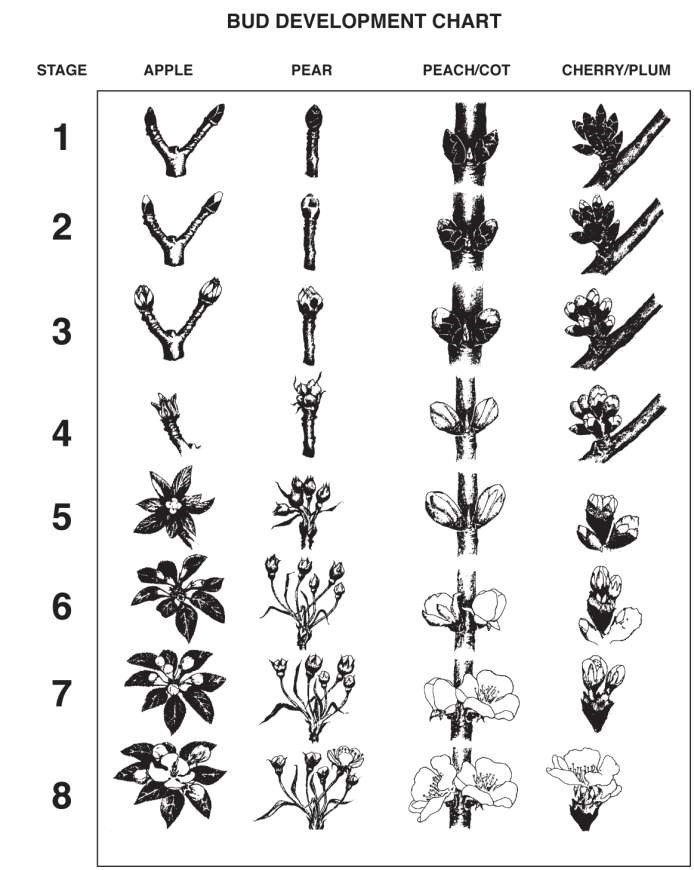
Winter
Apples and Pears:
Bud stage 1 (dormant bud): Apply dormant oil, being sure to thoroughly coat the branches and trunk bark, to help control codling moth. This spray is only recommended if you have had codling moth in your fruit.
Peaches:
At bud break or stage 2 (see Bud Development Chart), apply copper sulfate to protect for Peach Leaf Curl. Spray every 3 weeks for a nine-week period (3 sprays) or until the tree is leafed out. Resistant varieties like Frost Peach develop resistance but should be sprayed until established.
Pears (plantings less than 2 years old):
When first green shows in buds, apply copper sulfate or fixed copper, or copper soap to prevent pseudomonas (bacterial dieback) infection. Asian pears are most susceptible.
Spring
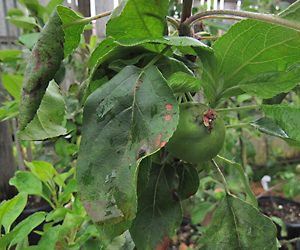
Scab infection on apple leaves
Apples and Pears:
Between stages 4-6 apply a delayed dormant spray of micronized sulfur and horticultural oil. This spray helps protect the trees against powdery mildew infections and smothers eggs and crawlers of aphids, mites, leafrollers, and scale insects.
Between stages 6-7 apply a spray of micronized sulfur (no oil) to prevent apple scab, pear scab, and powdery mildew. This spray is not necessary for varieties resistant to these diseases. Bacillus thuringiensis (Bt.) can be added to this spray to help control leafroller. Bt. can also be applied separately or mixed with insecticidal soap to control leafrollers and cutworm at this time.
At petal fall apply a second scab and mildew spray, using micronized sulfur (no oil). Bacillus thuringiensis (Bt.) can be added to this spray to help control leafroller. Bt. can also be applied separately or mixed with insecticidal soap to control leafrollers and cutworms at this time.
Apricots:
At stage 3 apply a delayed dormant spray of copper mixed with horticultural oil. Copper is somewhat effective against blossom blight and brown rot, and the oil will smother eggs and crawlers of overwintering pests. Never use sulfur on apricots as it can burn the foliage.
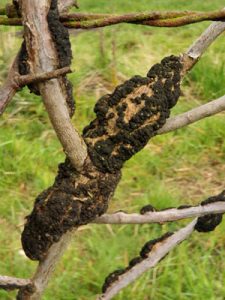
Black knot on plum
Peaches, Cherries, and Plums:
At stage 3 apply a delayed dormant spray of sulfur mixed with horticultural oil. Sulfur is effective against blossom blight and brown rot, and the oil will smother eggs and crawlers of overwintering pests.
Plums:
If black knot has been observed, prune out affected branches 2-3 inches below the knot.
Summer
All Fruit Trees:
Monitor foliage for aphids, leafrollers, cutworms and other insect pests. Spray if damage is apparent. Insecticidal soap or summer oil are effective on aphids. Bt. is effective on caterpillars and leafrollers, and most effective sprayed late afternoon or on cloudy days.
Apples, Pears:
Monitor and control codling moth and apple maggot- details to follow. Remove fruit with obvious stings (entry holes) and destroy.
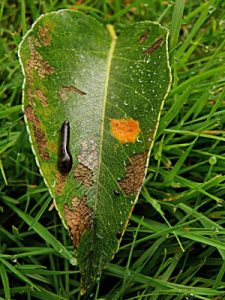
Pear trellis rust (orange spot) and pear slug
Pears and Cherries:
Monitor for pear slug (actually a sawfly larvae). Hand pick small numbers. Spray larger infestations with insecticidal soap, neem oil, or dust with diatomaceous earth. Monitor for pear trellis rust on pear trees- pick and destroy leaves with orange spotting. If possible remove junipers from area (alternate host for pear trellis rust).
Plums:
Monitor for black knot infections, and prune below the knots after harvest.
Fall
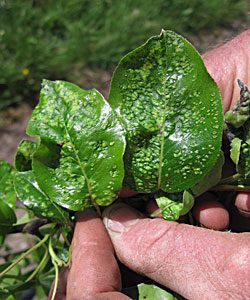
Leaf with pear blister mite
Pears:
If blister mite has been observed, spray lime-sulfur (Calcium polysulfide), micronized sulfur or sulfur plus horticultural oil just after leaf drop, thoroughly covering all buds and bark. Spray again in spring at bud break.
All Fruit:
Rake up and destroy fallen leaves and fruit. If codling moth or apple maggot has been a problem, do not compost but discard the fruit. Fruit trees prefer a soil pH of 6.8-7. At this pH, the trees can make use of the nutrients available in the soil. Our native soils typically are 5.5 or below- acidic. If a pH test of your soil shows acid conditions, apply lime in the fall. In addition to raising the soil pH, lime will supply calcium to the trees, important for good fruit quality, and also help fallen foliage decay. Some studies show liming in the fall can lessen scab spores the following spring.
All Year
- Prune your trees to keep them open to light and air circulation
- Keep the orchard clean, removing diseased wood, foliage, or fruit when present. Rake up fallen leaves in the fall, or mow them so they decay quickly.
- Keep the trees adequately watered in summer. Stressed trees are more prone to problems.
- Encourage your neighbors to keep their fruit trees healthy, too. Pests don’t recognize your property boundaries!
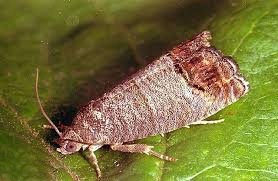
Adult codling moth
Codling Moth
Codling Moth is a common pest of apples and pears in Western Washington. The adult moths emerge at about full bloom (of apples), mate as soon as the twilight temperatures are above 55°F, laying the first generation of eggs after mating. The eggs take 8- 21 days to hatch, and the larvae immediately bore into the fruit. Larvae reach full growth in 3-4 weeks, emerge from the fruit and look for a sheltered place to spin a cocoon, at the base of the tree or beneath bark scales on the tree. Larvae may pupate in 2-3 weeks and emerge as a 2nd generation of adults, or they may remain as larvae, pupating and hatching the following spring. In our cool summer climate, there are usually 1 or 2 generations each summer; in a warm summer there may be 3 generations. Fruit that has been inhabited by codling moth larvae will have tunnels, usually to the core area. Tunneled fruit will drop early.
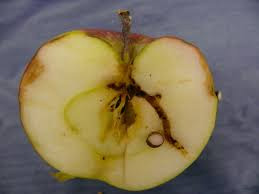
Codling moth damage in apple
Management Strategies
In the home orchard, use a combination of strategies to combat codling moth.
- Sanitation in the orchard is the most important strategy. Remove infested fruit early and discard it (do not compost). You can recognize early infestation by a “sting” mark on the fruit, usually a black or brown spot, often surrounded by frass (caterpillar poop).
- Encourage birds, bats, and beneficial insects that may prey on moths. (This includes yellow jackets and bald faced hornets.) Chickens free ranging in an orchard will help with moth control.
- Thin the young fruit so it has room to develop without touching.
- If codling moth pressures are high, it may be necessary to use an insecticide. An effective, low toxicity material for controlling codling moth and other caterpillars is spinosad, made from a naturally occurring bacterium called Saccharopolyspora spinosa. Various trade names are Monterey Garden Insect Spray, Bulls-eye Bioinsecticide, or Green Light Spinosad Lawn & Garden The addition of a 1% summer oil to the spray will further enhance the effectiveness of spinosad by smothering unhatched eggs.
- Historically for Whatcom County, timing of the first spray will be mid-June. Try spraying around the 10th-15th of June- earlier in warm years, later in cool- and then again in 21 days. For more detailed timing of sprays look at this site: uspest.org. A tutorial at our website on our blog called Codling Moth Tracking Tool will help you set up disease and pest models, including codling moth, using your nearest local weather station.
- Another product, Last Call CM, uses a pheromone attractant and an insecticide in a resin that is applied in drops along the branches once a month starting at petal fall. The male moths are attracted to the resin, try to mate with the drop, and are killed by the insecticide. No insecticide is applied to the fruit.
- A second spray option is to use a kaolin spray product (Surround) that makes the fruit unrecognizable to codling moth (and apple maggot). This product is sprayed beginning at petal fall, to thoroughly coat the trees and fruit kaolin clay. Rainy weather may require spraying every 7-10 days through mid-July or until harvest if apple maggot is a Because this product works best with constant agitation during the spray, it is less effective for those using pump up or backpack sprayers than those who have commercial powered spray tools.
- A high labor, but effective home remedy for apple maggot with some deterrence for codling moth is to bag each individual fruit after the thinning is done. Nylon footies or maggot barriers are effective insect barriers and control apple maggot and are about 60%-80% effective against codling moth if applied early enough. Slip the developing fruit into the toe of the footie, and twist it to secure. The nylon stretches as the fruit grows. Footies are available with detail instructions through Cloud Mountain Farm Center and the Seattle Tree Fruit Society.
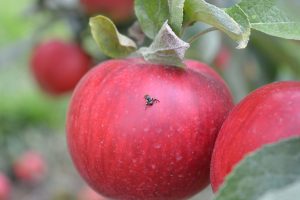
Apple Maggot fly on fruit
Apple Maggot
Apple Maggot is becoming increasingly common in Northwest orchards. Female apple maggot flies deposit eggs singly just below the skin of an apple or other host fruit. When the female lays an egg, a small but visible puncture is made in the fruit which can lead to “dimpling.” Depending on temperatures, the eggs hatch after a 3-7 day incubation period. The tiny cream-colored larvae (maggots) feed in the fruit, passing through three growth stages. Maggots are about 3/8 inches long. The damage caused by the maggot resembles a series of brownish, irregular tunnels called railroading. The tunnels are enlarged by bacterial decay that often follows apple maggot damage. Damaged fruit eventually becomes soft and rotten and cannot be used. Early ripening varieties are most likely to be damaged.
Management Strategies
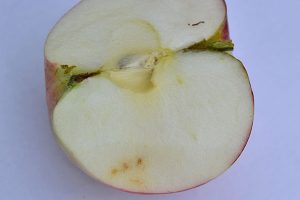
Damaged apple from apple maggot
- Sanitation in the orchard is crucial. Remove all fruit with signs of maggot and dispose of it (do not compost).
-
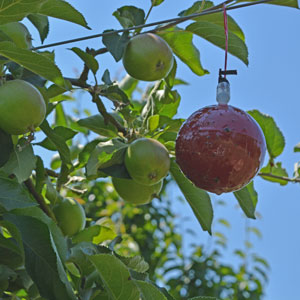
Apple Maggot Trap
For light infestations, sticky traps with a pheromone lure- red balls shaped like apples, or yellow sticky cards – are hung by early to mid-July in the trees near the top of the canopy to trap adult flies. 3-6 traps per tree are necessary depending on tree size. Fewer traps (1 per 3-4 trees) can also be used to monitor for adult flies for spray timing.
- If spraying, use traps to monitor for flies and spray when 3-5 adult flies are found on the traps. Spinosad and Neem extracts (Azadirect) are two products that are somewhat effective controls. After spraying, clean or replace the monitoring traps. Usually 2-3 sprays are needed during the season.
- Physical barriers on the fruit is labor intensive but very effective. Nylon footies are effective insect barriers and control apple maggot and provide some control for codling moth. Slip the developing fruit into the toe of the footie, and twist it to secure. The nylon stretches as the fruit grows. Footies are available with detail instructions through Cloud Mountain Farm Center, the Seattle Tree Fruit Society.
- Kaolin clay, sold as Surround, should be applied early July through August to provide control for apple maggot. Trees are sprayed to runoff, at a rate of 25-50 lbs per acre. This product must be agitated while spraying.
